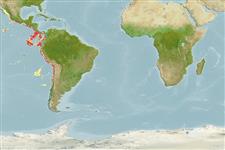>
Gadiformes (Cods) >
Macrouridae (Grenadiers or rattails)
Etymology: Nezumia: A Japanese word that means "mouse" .
More on author: Garman.
Environment: milieu / climate zone / depth range / distribution range
Ecologia
marino batidemersale; non migratori; distribuzione batimetrica 600 - 1870 m (Ref. 9315). Deep-water; 27°N - 34°S, 112°W - 70°W (Ref. 1371)
Eastern Pacific: Gulf of California south to Chile, including the Cocos and Galapagos islands.
Size / Peso / Age
Maturity: Lm ? range ? - ? cm
Max length : 30.0 cm TL maschio/sesso non determinato; (Ref. 1371)
Spine dorsali (totale): 2; Spine anali 0. Snout short, moderately pointed, with stout scutes at its tip and lateral angles; underside of the snout and suborbital anteriorly naked. Light organ not well-developed externally; no scaleless fossa between the pelvic-fin bases. Pyloric caeca 21 to 32. Body scales with conical spinules in 10 to 12 slightly convergent rows.
Most common grenadier in the Eastern central Pacific but occurs in very deep waters that it is not regularly taken by trawlers (Ref. 9315). Maximum TL of at least 30 cm (Ref. 9315).
Life cycle and mating behavior
Maturità | Riproduzione | Deposizione | Uova | Fecundity | Larve
Cohen, D.M., T. Inada, T. Iwamoto and N. Scialabba, 1990. FAO species catalogue. Vol. 10. Gadiform fishes of the world (Order Gadiformes). An annotated and illustrated catalogue of cods, hakes, grenadiers and other gadiform fishes known to date. FAO Fish. Synop. 125(10). Rome: FAO. 442 p. (Ref. 1371)
IUCN Red List Status (Ref. 130435)
Threat to humans
Harmless
Human uses
Pesca: pesca di sussistenza
Informazioni ulteriori
Nomi ComuniSinonimiMetabolismoPredatoriEcotossicologiaRiproduzioneMaturitàDeposizioneSpawning aggregationFecundityUovaEgg development
Age/SizeAccrescimentoLength-weightLength-lengthLength-frequenciesMorfometriaMorfologiaLarveDinamica popolazioni larvaliReclutamentoAbbondanzaBRUVS
BibliografiaAcquacolturaProfilo di acquacolturaVarietàGeneticaElectrophoresesEreditarietàMalattieElaborazioneNutrientsMass conversion
Strumenti
Special reports
Download XML
Fonti Internet
Estimates based on models
Preferred temperature (Ref.
123201): 4 - 5.7, mean 4.9 °C (based on 48 cells).
Phylogenetic diversity index (Ref.
82804): PD
50 = 0.5000 [Uniqueness, from 0.5 = low to 2.0 = high].
Bayesian length-weight: a=0.00219 (0.00111 - 0.00431), b=3.20 (3.03 - 3.37), in cm total length, based on LWR estimates for this (Sub)family-body shape (Ref.
93245).
Trophic level (Ref.
69278): 3.3 ±0.1 se; based on size and trophs of closest relatives
Resilienza (Ref.
120179): Basso, tempo minimo di raddoppiamento della popolazione 4.5 - 14 anni (Preliminary K or Fecundity.).
Fishing Vulnerability (Ref.
59153): Low vulnerability (20 of 100).
